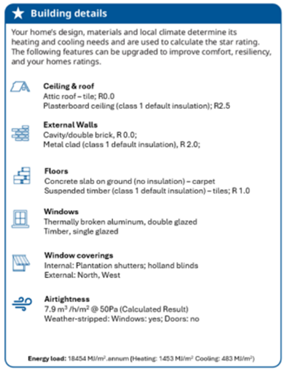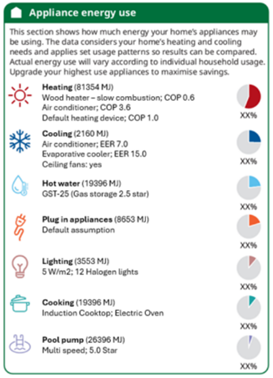After your home’s energy performance is assessed, you will receive a Home Energy Rating certificate. This certificate can help guide you through decisions to improve your home’s comfort and reduce energy bills and emissions.
Your certificate includes:
- a star rating (out of 10)
- a home energy rating (out of 100)
- estimates of your home’s annual energy use and greenhouse gas emissions
- information on appliance performance and predicted energy use
- an indication of your home’s predicted comfort level without heating or cooling
- the renewable energy profile for your home (if relevant).
You can use the certificate to:
- compare your home against other homes in Australia
- identify areas where energy performance and comfort can be improved
- discuss potential upgrades with tradespeople, energy professionals or assessors
- inform future home improvement plans, potentially increasing energy savings.
Existing home energy ratings cannot be used for regulatory compliance with the National Construction Code. If you need a rating to demonstrate compliance for a new home or major renovation you will need a NatHERS Certificate.
Understanding your certificate
Click on the headings below to learn about your certificate, including what the ratings mean and what’s gone into the assessment.
Improving your home
The second page of the certificate includes upgrade guidance, relevant to the climate zone your home is located in, with information on options to improve energy performance. For more information on climate zones, visit this climate zone map.
Upgrade guidance provides quick wins — such as draught proofing, better insulation, installing quality window coverings and external shading — that can improve comfort and reduce your energy bills. Simple, no cost actions to help maintain comfort in seasonal extremes are also outlined.
The guidance may also suggest more extensive upgrades, such as electrification of appliances and installing rooftop solar and battery storage, which saves energy and money in the long term but will have higher upfront costs.
The costs, benefits and feasibility of these options will vary for each home, depending on its construction and local climate as well as heritage and owners’ corporation provisions. For more detailed upgrade information and to plan or prioritise your upgrades, speak to your energy assessor.
Additional resources are available at:
Explanatory notes and disclaimers
Complaints and handling process
If you have a question about the information on the certificate relating to your home, ask the accredited assessor who completed the assessment. The business name and contact information are included on the certificate.
If you want to check your certificate is authentic, scan the QR code on your certificate. It should link to an online version. If it does not, or the certificate details differ online, email admin@nathers.gov.au.
For general questions, to provide feedback or make a complaint, email admin@nathers.gov.au.




